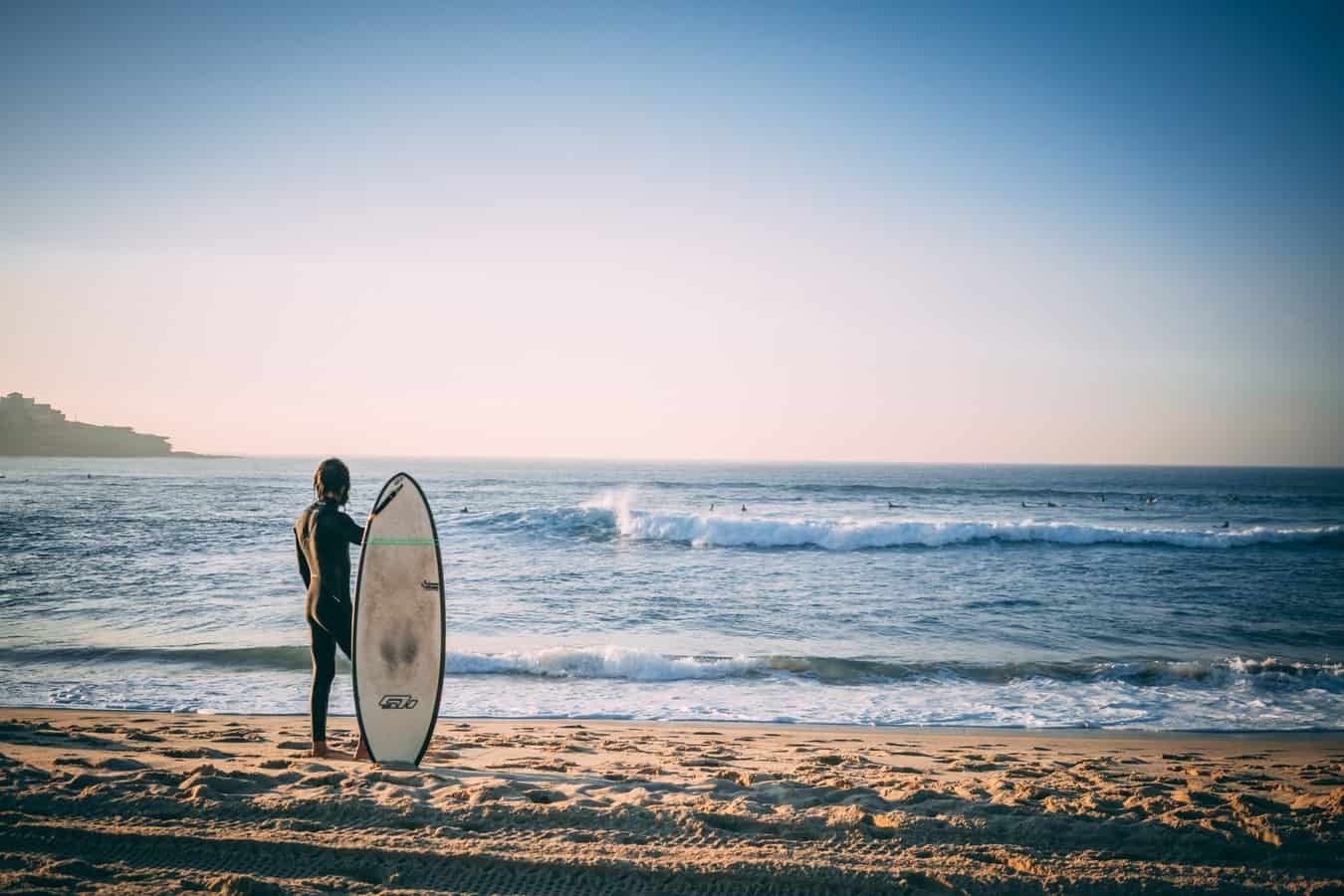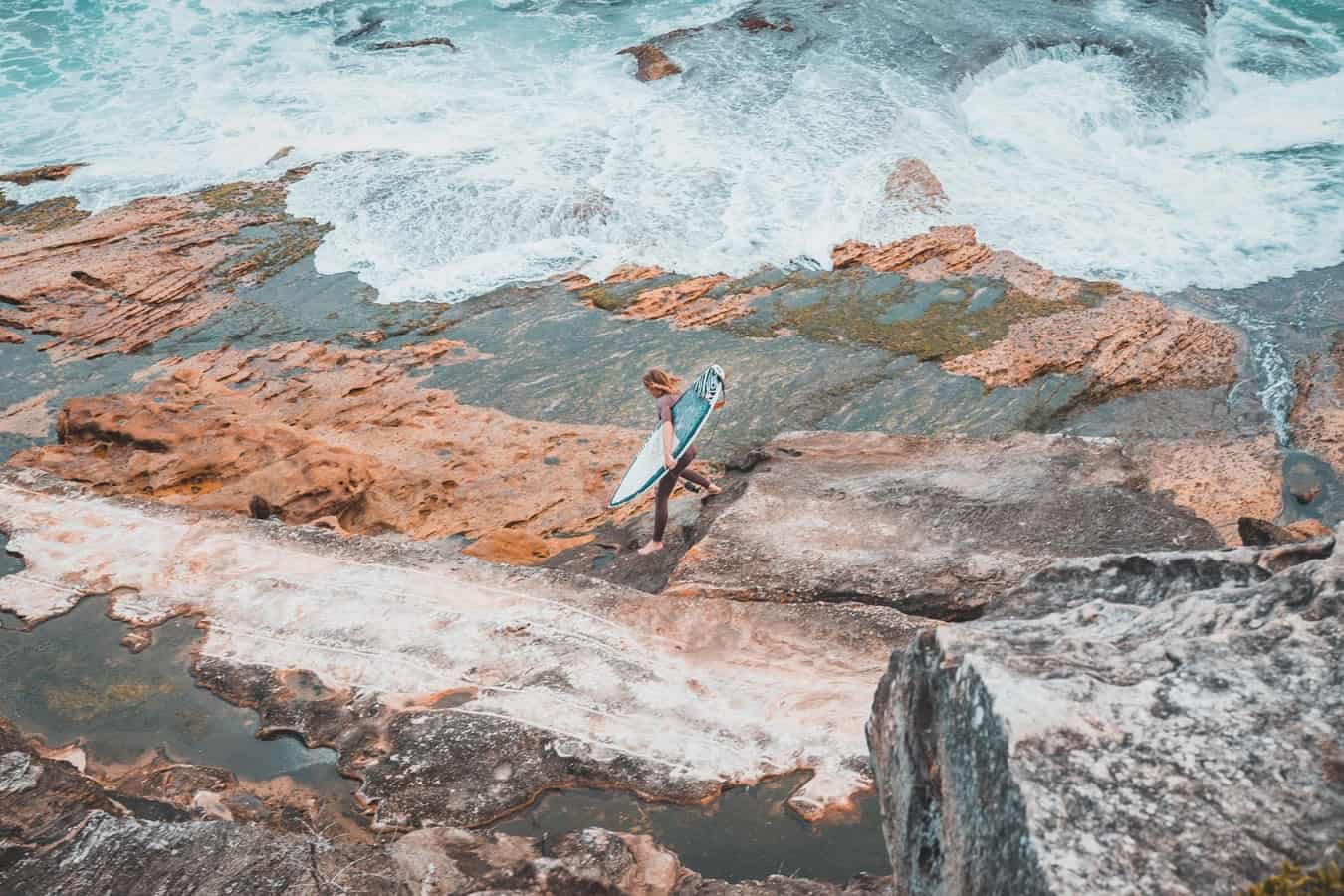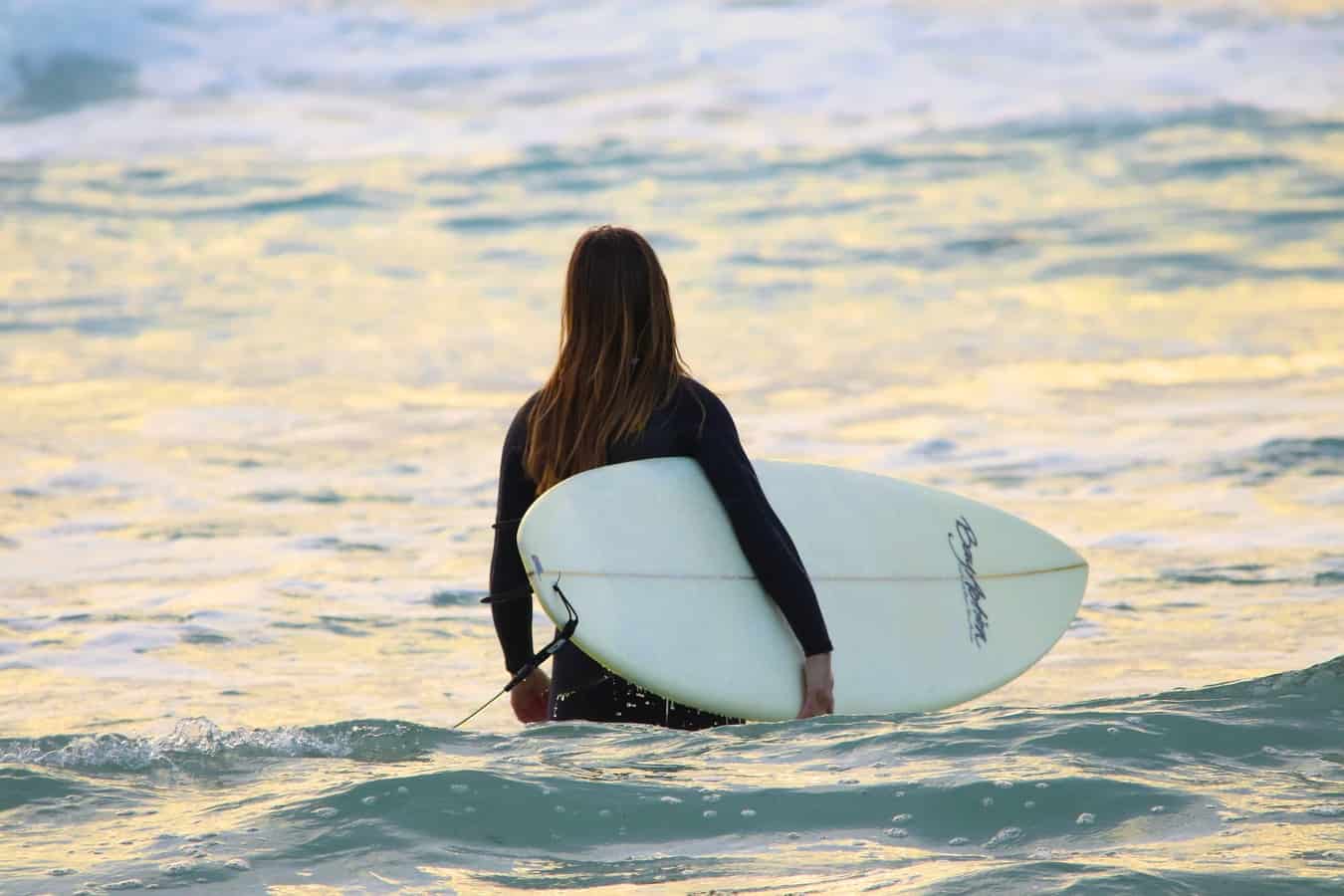At some point or another, you have watched professional surfers riding big, beautiful waves and you’ve imagined yourself doing it. Surfing takes years to master, but you can learn how to surf in just a few hours. If you don’ have the money or the time to invest in surfing lessons, I’m going to share what I’ve learned from over 20 years of surfing and teaching everyone from beginner to lessons for pros. Here I will answer the question, ‘how do you teach yourself how to surf?”
You’ll have success at surfing when you understand the motion of the water and what happens when the wave takes you. There are only a few prerequisites to learning how to surf, but if you have the desire and a love of being in the ocean, you will overcome all obstacles.
You Can Learn To Surf At Any Age
Surfing is a physically intensive sport that requires stamina, resiliency, and endurance. If you keep yourself fit with exercise, you can begin surfing either as a teenager or in your 60s. Here are a few activities you can cross train in to prepare your body (and mind) for surfing.
- Swimming is a great exercise that helps strengthen the muscles in the body that are used the most for surfing. Most of the time you’ll spend out in the water, you’ll be paddling on your surfboard, using your arms to paddle and your legs to kick.
You’ll also use your core muscles, including the abdominals, and the muscles along the sides of the body. Your shoulder muscles are engaged when you paddle, too, as well as the muscles in your upper back (lats) and your chest.
Paddling on a longboard is almost the same as freestyle swimming, which is when you swim one arm at a time, your legs kicking efficiently behind you. Freestyle swimming is the best preparation you can do to prepare yourself for the rigorous paddling you’ll be doing in the ocean.
When I teach lessons to beginning surfers, I have them lay on a surfboard placed in the sand and I show them how to paddle before they get into the water.
If you swim regularly and were in my surfing class, you will advance quickly beyond this step and I’d likely move you into the ocean to paddle there. The more familiar students are with water activities and watersports like swimming, the faster they’ll be out in the surf.
- Bike Riding. Boke riding is a wonderful exercise to get your heart pumping. Surfing relies on a well-tuned cardiovascular system, so bike riding increases the heartbeat to a level similar to paddling and catching waves. It also works the legs muscles that you’ll be using on the surfboard when you kick.
- Weight Training. Building up shoulder and upper back muscles are the key to surfing success. I strongly advise you to go to the weight room at the gym once a week and work on building up your biceps, triceps, shoulder, neck, lats, and core muscles. This will give you the strength you need. Watching people surf is deceiving; what looks easy and simple requires, in fact, well-developed muscles.
- This activity is not for physical conditioning as it is for increased endurance. You will be paddling 50 minutes out of every hour you are surfing. The more fine-tuned and ready your heart is, the more fun you will have.
- Push Ups. Once you reach the wave you want to ride, you’ll move from lying on the surfboard to pushing off it and into a standing position.
What To Do Before You Ride Your First Wave
There are a few things you need to do before you ride your first small wave. Here’s a basic list.
- Rent a surfboard your first time at the beach.
Your first surfboard will be a longboard. Beginner surfers, as well as professional surfers, use a longboard. This surfboard is anywhere from 8 to 12 feet long, and one of the advantages it offers is volume and buoyancy. This means that a longboard is easier to stay afloat and balanced on than a shorter board.
Longboards are easier to paddle on and to pop up on when it’s time to meet your first wave. Beginner surfers in my classes start on longboards when they learn to paddle and perform turtle rolls. I take my surfers out to waves that are smaller, sloping, and gentler all around.
When you go to a surfboard shop to rent a longboard, you will choose one that is the right size based on your weight and height. The more you weigh, the larger the longboard will be in terms of its weight.
Surf shops are staffed by experienced surfers, so don’t be afraid to ask for help to make sure you get the right size board.
Ask for a longboard that will give you the most balance. The term for this is “volume.” The higher the volume a surfboard has, the easier it will be for you to balance yourself and remain standing.
- Buy a west suit if the surf shop suggests it.
It’s a must that you check weather conditions before going out to surf for your first time. Variables like the tides, the wind and especially the water temperature will let you know if you should wear a wetsuit that day.
If the water temperature is 65 degrees or below, you must wear a wetsuit. A wetsuit keeps your body warm and prevents hypothermia. It is form-fitted so it’s comfortable. If you wear it a lot you will forget you have it on.
Wetsuits come in full-body models as well as only jackets or vests. Again, ask the surf shop staff for advice on what to buy for the day you plan to surf.
- Get surfboard wax.
Surfing the board before using it in the ocean is very important to help you have a better foot grip when standing, and help you stay balanced.
Surf wax is inexpensive and easy to apply. Make sure to cover the entire top side of the board, especially the rails, or edges of the longboard.
Make sure not to get sand in the wax; it will feel abrasive under your feet and will scratch your stomach.
- Make sure you get a surfboard leash.
Every longboard has a plug to which you attach the surfboard leash. The leash has a Velcro strap and fits comfortably around your ankle.
The surfboard leash is worn by beginners as well as experienced and professional surfers. The least helps you stay attached to your surfboard when you wipe out on a wave. It also serves to protect other surfers from getting hit by your surfboard when they’re paddling or riding a wave.

Surfing Safety For You And Other Surfers
I’m not trying to discourage you here, but surfing can be dangerous. You must surf intelligently and be aware of obstacles around you and avoid them at all costs. By obstacles, I mean other surfers for the most part, but also reefs, rocks below the surface of the water, and the different kinds of currents in the water, especially rip currents.
- Are You A Strong Swimmer?
There’s no way around this one. You are in the water surfing, and you find yourself being towed out to sea by a rip current. Making a beeline to the shore will not work. What do you do?
You wipeout and the waves thrust you down to the sea bed, and the water is over ten feet deep. You are disoriented and you have about 12 seconds to make it back to the surface. Which way is up?
Surfing involves a different kind of swimming, namely paddling. Doin freestyle swimming laps in your pool or a gym’s 75-feet Olympic-sized pool is a great way to prepare for paddling.
He more you paddle, the faster you can move on your surfboard, and the better you will be in avoiding danger in the water.
I recommend you spend an hour paddling in the water on your surfboard before riding a wave. Do this every day, making your shoulder and arm muscles strong in the process. Being a powerful weightlifter with bulging muscles won’t improve your ability to paddle away from danger out to safety. The more you paddle, the better surfer you’ll be.
- Keep Your Head Protected
No matter what level of expertise, surfers are going to wipeout. When this happens, the ocean manipulates your body and throws you wherever it wants to. There is nothing you can do but go along the ride, and the ride can be fun if you’re careful.
Our instinct to just let the wave take us where it will. But on the way down you have to stay alert and cover your head with your arms, so that when you hit the sea bottom, you can avoid a concussion, or worse, going unconscious.
The main reason surfers drown is because they go unconscious underwater. Even when wearing a surf leash, once a surfer stops breathing, critical seconds pass by.
- Hold Your Surfboard At Your Side
The classic mistake beginner surfers make is placing their surfboard in front of them as a wave approaches. They get ready to stand on the board, but the wave suddenly breaks in front of them and the board crashes into their body.
If you are standing in whitewater in low tide and a great-looking wave comes, hold your board by your side and prepare to stand on it at the right movement. It is easier to climb onto a surfboard when it’s by your side than when it’s in front of you.
- Observe Surfing Etiquette
Respect other surfers especially when the sea is crammed with surfers. Maintain a safe distance from other board riders.
Only one person is riding a wave at a time, so avoid “dropping in” on a surfer and the way he or she is getting on.
Look on your inside to see if somebody is paddling towards a wave. If you drop in by ancient on someone, turn your surfboard at an angle away from them, towards the unbroken part of the wave, and kick away as soon as possible.
The rule is that whoever is nearest the wave peak has the first right of refusal. If he or she decides not to take the wave, the wave passes and the next rider in line now decides to take or pass on the wave.
If you know you are going to roll or wipeout, don’
Never throw your board away from you. It can hit another surfer. This happens often when the offending surfer is not aware there was someone else nearby. As a rule of thumb, hold onto it at all times. Wear a surfboard leash.
As a beginner, I highly advise you not to surf on a day the beach is crowded. This will only make it harder for you to get into your new routine of paddling and wave riding. Besides, you can be injured by other surfboards or you can accidentally cause injury to another surfer.
I never let my beginner surfers take to the water when it’s full of swimmers and surfers. This is why I often hold classes early in the morning or late in the day when there are a lot of open stops in the water.
Don’t take on big challenges on your first day. Surf at a beach where there are a lot of smaller waves and a lot of whitewater. Stick to shallow water, stand up in waves and try to stay balanced.
Only surf whitewater waves at first. These are waves that are foamy and slower moving, hence the term “whitewater.” Keep surfing on these until you can ride them confidently.
Know the ocean. Ask a lifeguard if he’s noticed anything that might make surfing more difficult that day. He may say there are lots of rip currents in the ocean, or that there are rock formations underneath the surf.
If you are an experienced swimmer, you can take the chance with a rip current. Swim parallel to the shore and slowly move your body in more and more to the beach.
Swimming directly against a rip current will not work. Rip currents, or “rip tides,” is a powerful current that moves in the opposite direction of the shoreline. The only way to get out of one is to not swim against it, but instead along the line of current.
At the current’s endpoint, reverse the direction of your swimming and move in a little at a time. Repeat reversing and swimming in a little, and you will eventually get out of the current force. Then you can walk to the shore or swim easily.

Different Kinds Of Waves You’ll Encounter
Each day out at the beach will have surf conditions completely different. No 2 days are alike. Part of how to teach yourself how to surf involves knowing the different kinds of waves to ride. Once you are good at riding whitewater, you may want to try these different kinds of waves.
Reef Break Waves
This kind of wave is found near coral shelves and rock formations that jut out into the ocean.
I highly advise any beginner to avoid reef break waves. It is extremely dangerous to surf near rocks and coral reefs in the first place; many experienced surfers have drowned after riding these big, powerful waves. You can try these after 9 months if you’d like, and it won’t hurt to check with other surfers who can tell you their experiences riding reef break waves.
Beach Break Waves
Beach break waves can be tricky, but they’re the best bet for beginner surfers. This kind of wave occurs in areas where the sea floor is soft and sandy, with little or no rocks under the surf.
However, unlike the consistent reef break waves, which are often the same size and shape, each reef break wave is different than the previous wave. These are great waves to testy your skill riding waves of different sizes and strengths.
Point Break Waves
After a few months of surfing and gaining the ability to catch and ride waves, beginners can try point breaks waves. This kind of wave happens in areas where the beach juts out into the water, or jetties are protruding into the sea.
These anomalies make for great waves, some of them tall and strong, others similar to whitewater waves. It is important to be careful riding point break waves because no matter what size they are, they pack a strong punch and can carry you a long distance before you wipe out.
Ride point break waves if you are confident in your swimming and paddling skills because you’ll want to avoid the rock or sand formations that jut out into the water.
How To Approach And Ride A Wave
The best way to approach waves, whether it’s whitewater or barrel waves, is from the side. As you paddle towards the wave, your surfboard should be parallel to the shoreline then the wave moves in a straight line to the shore.
As you paddle, keep looking at the wave, see his it rises and pick the right movement to catch. This is just before the wave begins to break. You will notice foam building up along the wave crest. This is the tome to take the wave, pointing the nose of your board at a right angle to the wave.
In every case, you try to approach the wave from the end or side of the wave. Paddle to the side and make your board perpendicular to the wave. Next, stand up and let the wave carry you to shore.
Now that you’re riding the wave, keep your feet in one spot on the board. Bend your knees and keep your arms loose. Always look in the direction the wave is carrying you. Once you’re better experienced at surfing, this is your moment of bliss, where the only thing that matters is the feel of the board beneath your feet and what’s in front of you.
Rode the surfboard straight in. You don’t have to stay on the wave as long as possible at first. Surf to the shore in a straight line. When you are more experienced you can angle the board and move it along the curve of the wave to stay on longer.
With safety in mind, physical fitness and wearing a surfboard leash you’re ready to go out and start to fall in love with surfing. Getting good at it takes a long time, so be patient. As you surf, as you build confidence to begin taking on new challenges. Always ask more experienced surfers for help.

